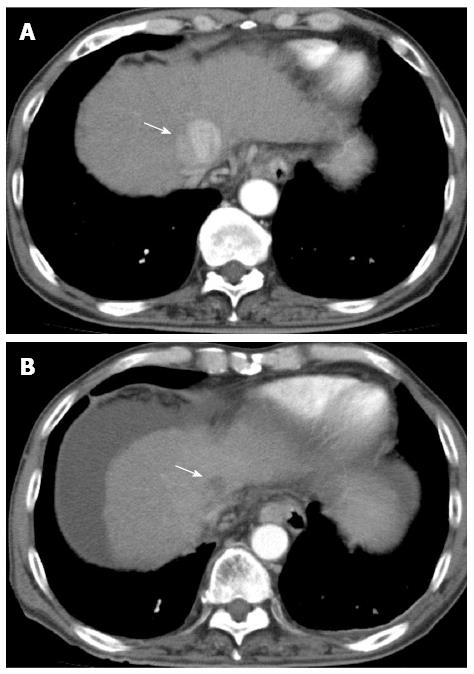Copyright
©The Author(s) 2015.
World J Gastroenterol. Dec 28, 2015; 21(48): 13490-13499
Published online Dec 28, 2015. doi: 10.3748/wjg.v21.i48.13490
Published online Dec 28, 2015. doi: 10.3748/wjg.v21.i48.13490
Figure 4 Clinical example of patient had late adverse events by CyberKnife®.
A 66-year old male with hepatitis B virus cirrhosis received CyberKnife® therapy at a dose of 42 Gy in 3 fractions for hepatocellular carcinoma sized 40 mm in diameter in S4. The Child-Pugh score before the treatment was 7 and the score rose with 13 when 12 mo after the treatment. After he died of liver failure. A: Dynamic computed tomography (CT) scan in arterial phase before the treatment showed a hypervascular lesion in S4 (arrow); B: The lesion was showed as a hypovasclular lesion on dynamic CT scan in arterial phase 12 mo after the treatment (arrow), but dynamic CT scan showed liver atrophy and massive ascites.
- Citation: Shiozawa K, Watanabe M, Ikehara T, Matsukiyo Y, Kogame M, Kishimoto Y, Okubo Y, Makino H, Tsukamoto N, Igarashi Y, Sumino Y. Comparison of percutaneous radiofrequency ablation and CyberKnife® for initial solitary hepatocellular carcinoma: A pilot study. World J Gastroenterol 2015; 21(48): 13490-13499
- URL: https://www.wjgnet.com/1007-9327/full/v21/i48/13490.htm
- DOI: https://dx.doi.org/10.3748/wjg.v21.i48.13490









